October 2012 Volume 15 Number 4 - Educational Technology ...
October 2012 Volume 15 Number 4 - Educational Technology ...
October 2012 Volume 15 Number 4 - Educational Technology ...
You also want an ePaper? Increase the reach of your titles
YUMPU automatically turns print PDFs into web optimized ePapers that Google loves.
MS1 (Sung et al., 2008): This system is a mobile guide system, which is a web-based system and operated in<br />
tablet PC. The system mainly provides visitors with map and multimedia presentations of exhibits. Here, the<br />
multimedia presentations include photo, audio, and text.<br />
MS2 (Vavoula et al., 2009): This system is an inquiry learning system, which is the combination of web-based<br />
and client-based systems and operated in mobile phone. The system mainly provides visitors with multimedia<br />
presentations of exhibits and a set of functions for supporting their inquiry learning in museum. Here, the<br />
multimedia presentations include photo, illustration, and text.<br />
MS3 (Pianesi et al., 2009): This system is a mobile guide system, which is a client-based system and operated in<br />
PDA. The system mainly provides visitors with multimedia presentations of exhibits and location-awareness<br />
service. Here, the multimedia presentations include audio and video; the location-awareness service signifies<br />
that the system provides visitors with the multimedia presentation according to the location of visitors.<br />
MS4 (Ghiani et al., 2009): This system is a mobile guide system, which is a client-based system and operated in<br />
PDA. The system mainly provides visitors with map, multimedia presentations of exhibits, location-awareness<br />
service, and personalized service. Here, the multimedia presentations include photo, video, and text; the<br />
location-awareness service implies that the system provides visitors with a path to a specific exhibit from the<br />
current location; the personalized service means that the system guides visitors to visit their favorite exhibits.<br />
MS5 (Reynolds et al., 2010): This system is a mobile guide system, which is a web-based system and operated<br />
in PDA. The system mainly provides visitors with the multimedia presentations of exhibits, a set of functions for<br />
supporting visitors to explore museum and exhibits. Here, the multimedia presentations include photo, audio,<br />
video, and text.<br />
MS6 (Sung et al., 2010): This system is a mobile guide system, which is a web-based system and operated in<br />
tablet PC. The system mainly provides visitors with map and multimedia presentations of exhibits. Here, the<br />
multimedia presentations include photo, audio, and text.<br />
Table 10. Comparative analysis of museum systems<br />
Criteria/Museum system PGR system MS1 MS2 MS3 MS4 MS5 MS6<br />
Client/Web Client Web Client & Web Client Client Web Web<br />
Device Netbook computer Tablet PC Mobile phone PDA PDA PDA Tablet PC<br />
Location-aware Yes No No Yes Yes No No<br />
Personalized Yes No No No Yes No No<br />
Multimedia Yes Yes Yes Yes Yes Yes Yes<br />
Map No Yes No No Yes No Yes<br />
Management Yes No No No No No No<br />
Conclusion<br />
Museum learning has considerable potential for informal learning, but IO is harmful to museum learning. In this<br />
paper, we developed a PGR system to assist visitors in engaging in such learning. The system applied collective and<br />
individual visiting behavior to recommend personalized guides for visitors. In this way visitors are capable of<br />
avoiding a situation of dealing with a large number of exhibits; that is to say, IO could be eased through a<br />
personalized guide. To explore user satisfaction with the PGR system, a user satisfaction questionnaire was<br />
developed. The assessments of reliability and validity demonstrated that the questionnaire was appropriate for further<br />
analysis of its results. The results showed that the PGR system obtained overall positive feedback among both<br />
females and males. In the meantime, the relationship between system service quality and user age was found to be<br />
significant. The users’ prior experience with computer use was inferred to be the main factor contributing to this<br />
relationship.<br />
Although the proposed system had demonstrated benefits, some problems remain and should be addressed in future<br />
research. In this study, the category that occurred the most frequently among visited exhibits was used as user<br />
interest. However, the time for visiting exhibits also needs to consider because visitors may spend a small amount of<br />
time visiting many exhibits for which they have little interest. Moreover, the presentation style of the system also<br />
needs to be considered since visitors’ ages ranged from very young students to the elderly. In future work, we will<br />
attempt to design a new way to recommend a personalized guide and present different display styles for visitors.<br />
Finally, the value of cat(Vc, REc) may be too discrete (either 0 or 1). In the current research, we focused on using the<br />
163

















